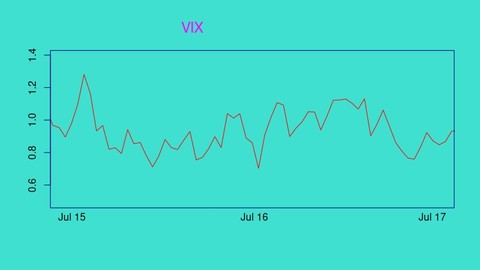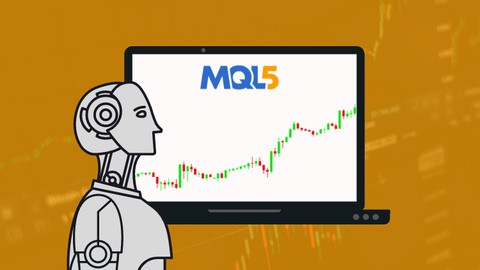Financial Derivatives: A Quantitative Finance View
Loại khoá học: Investing & Trading
The financial engineering of forwards, futures, swaps, and options, with Python tools for fixed income and options
Mô tả
Student Testimonials:
This course offers an unreal value. Very rich content! This beats any financial course I've taken at my university. Looking forward to completing this course and using some of these skills in my career.--Steven
Cameron is an outstanding teacher. Thank you very much for making the most important and difficult Finance concepts so easy to understand. Looking forward to the further courses.--Gevorg
I got (am getting) some intuition about quant finance, not just leaning facts without really understanding the concepts.
Cameron gives nice detailed answers to students questions.--Rich
Interested in a lucrative and rewarding position in quantitative finance? Are you a quantitative professional working in finance or a technical field and want to bridge the gap and become a full on quant? Then read on.
The role of a quantitative analyst in an investment bank, hedge fund, or financial company is an attractive career option for many quantitatively skilled professionals working in finance or other fields like data science, technology or engineering. If this describes you, what you need to move to the next level is a gateway to the quantitative finance knowledge required for this role that builds on the technical foundations you have already mastered.
This course is designed to be exactly such a gateway into the quant world. If you succeed in this course you will become a master of quantitative finance and the financial engineering of the most influential class of financial products that exist on markets today: derivatives.
About the instructor:
This course was created by a mathematician and financial quant holding a Ph.D. from the Courant Institute of Mathematical Sciences at NYU, and who earned his quant chops on Wall Street after an accomplished career as a theoretical materials scientist.
The focus of the course is thus very much on the practical skills someone working in the trenches in the real world of finance needs to have. But since the course author also has 10 years of college teaching experience, it is taught with an eye to sound course structure and sensitivity to the concerns of students.
What you will learn:
Many finance students and professionals find derivatives the most challenging subject in their field. But if you have a background in quantitative fields like statistics or computer science this course will show you that these most daunting of financial products are completely accessible to you.
Even if you are completely new to the world of finance, after completing this course you will have a deep mastery of the fundamental derivative structures traded on markets today: forwards, futures, swaps, and options. But since this course is presented by a practitioner you will also learn how derivatives are actually used in the real world, as tools for both speculation and risk management.
The world of finance and markets is fast-paced and exciting, but can also be very intimidating. In the heat of the moment, the markets are volatile and unpredictable, positions go south in unanticipated ways, you have traders yelling at you, you have computer software failing, you're relying on data you can't trust. Keeping your head above water in this environment can be well nigh impossible.
You need a conceptual framework that allows you to keep above the fray and keep your wits about you. In this course, my primary purpose is to convey that conceptual framework to my students. The same conceptual framework that allowed me to survive and thrive in the pits of Wall Street during the dark days of the financial crisis.
Concerned that you may not have the required background to succeed in this course? As long as you meet the formal prerequisites you need not be. A quantitatively strong business background is more than enough to meet these requirements. Any decent course in statistics and the basics of calculus is enough. In truth, high school mathematics is all that is needed for 80-90% of the course material. The most important requirement is simply to think analytically and logically.
Here is a sampling of some of the main topics that we'll cover on your journey into the quant profession:
Interest rate fundamentals
Periodic and continuous compounding
Discounted cash flow analysis
Bond analysis
The fundamentals of equity, currency, and commodity assets
Portfolio modelling
Long and short positions
The principle of arbitrage
The Law of One Price
Forwards, futures, and swaps
Risk management principles
Futures hedging
Stochastic processes
Time series concepts
The real statistics of asset prices: volatility clustering and autocorrelation
Fat-tailed distribution and their importance for financial assets
Brownian motion
The log-normal model of asset prices
Options
Put-call parity
The binomial model of option pricing
The Black-Scholes theory and formula
Option greeks: delta, gamma, and vega
Dynamic hedging
Volatility trading
Implied volatility
Includes Python tools
Python based tools are now included for computations with bonds, yield curves, and options. All software that is part of this course is released under a permissive MIT license, so students are free to take these tools with them and use them in their future careers, include them in their own projects, whether open source or proprietary, anything you want!
So Sign Up Now!
Accelerate your finance career by taking this course, and advancing into quantitative finance. With 23 hours of lectures and supplemental course materials including 10 problem sets and solutions, the course content is equivalent to a full semester college course, available for a fraction of that price, not to mention a 30 day money back guarantee. You can't go wrong!
Bạn sẽ học được gì
Learn the fundamentals of derivatives at a quantitative level
Master arbitrage, the core principle underlying derivatives, quantitative risk management and quantitative trading
Use derivatives to control and manage financial risk
Price forwards, futures, swaps and options
Understand the Black-Scholes theory and formula intuitively, avoiding stochastic calculus
Learn the limitations of the Black-Scholes theory, and how it is used in practice
Python based tools are provided for computations with bonds, yield curves, and options
Yêu cầu
- Calculus and a basic course in probability and statistics
- No knowledge or background in finance is assumed
Nội dung khoá học
Viết Bình Luận
Khoá học liên quan

Đăng ký get khoá học Udemy - Unica - Gitiho giá chỉ 50k!
Get khoá học giá rẻ ngay trước khi bị fix.


















Đánh giá của học viên
Bình luận khách hàng